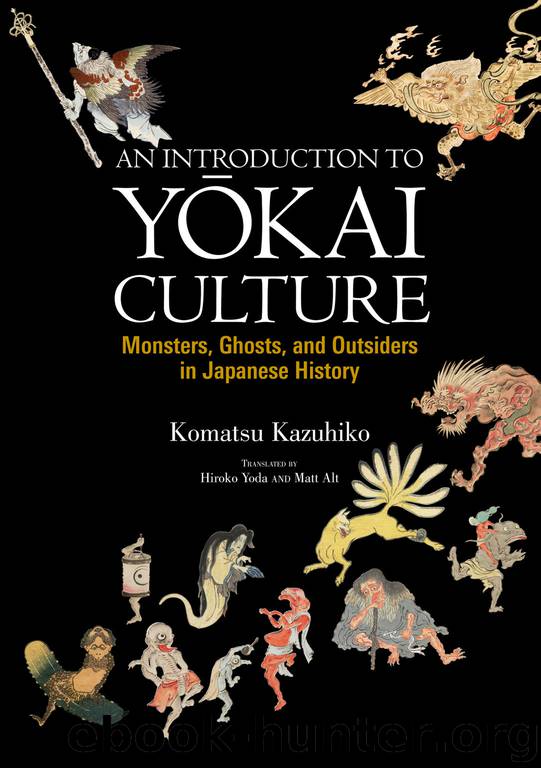An Introduction to Yokai Culture: Monsters, Ghosts, and Outsiders in Japanese History by KOMATSU Kazuhiko

Author:KOMATSU, Kazuhiko [KOMATSU, Kazuhiko]
Language: eng
Format: epub
Publisher: Japan Publishing Industry Foundation for Culture
Published: 2017-02-28T16:00:00+00:00
I suspect Sugae Masumi is most directly responsible. An early folklore scholar from the late Tokugawa era, he made the first visit to Oga to observe and report on namahage rituals. Publishing his findings as the paper “Oga no kanpu” (The Cold Winds of Oga), he called the namahage masks “oni masks” and the deities that descend to visit the village “oni .”
It isn’t surprising that he made this mistake. In the sketch he made while observing the event one of the two namahage masks shown looks very oni -like—it even has horns. Sugae was a scholar, but he was raised in a Japanese-speaking community and shared its concept of the oni . Upon seeing a ferocious, horned mask, he applied that label to it in spite of the fact that it was clearly called namahage in the local dialect. This is essentially the same process as the application of the label by Japanese speakers to outsiders and others.
This further implies that peeling off the oni label should reveal the form of the namahage ritual practiced by the locals at some point in the unrecorded past. Even if those namahage were said to be giants or village ancestor-spirits, folklorists should have made it clearer that they had no connection with the word oni used by the Japanese-speaking community. I actually think this is a more complicated issue than it seems, because it is likely that at some point in history the namahage rituals were influenced by the tsuina rituals held in Kyoto. Perhaps the ferocious horned mask was borrowed at that point.
In any case, Orikuchi and other folklorists following the idea that namahage were merely one type of oni succeeded in strengthening the bond between the label and namahage masks. As both the label and the popular characteristics of oni came to be known among locals, more namahage masks came to feature horns and faces evocative of oni . In the hands of these folklorists of the early modern period, namahage were incorporated into oni culture and transformed into namahage oni . This in turn fueled the fantasy that beneath the “namahage -as-oni ” label lay more ancient oni , without horns, who represented gigantic ancestral souls.
The True Form of Oni
Orikuchi’s oni thesis might have been expected to evaporate in the face of this analysis. In fact, however, the hypothesis that oni represented the spirits of ancestors came to be the accepted theory in folklore studies. What’s more, the idea that oni were ancestral spirits also informed interpretations of oni appearing later in the historical record. Imagery of oni as fearsome spirits was interpreted as a fallen, degraded form of the original oni beliefs. It was as though the folklorists were on autopilot, producing such interpretations reflexively whenever they saw an oni .
On the Kunisaki peninsula on the east coast of Kyushu, there is a festival called the Shujo-Onie (Honored Oni Festival) in which oni are portrayed as bringing prosperity to residents. Seeing this, folklorists might conjecture that the earliest
Download
This site does not store any files on its server. We only index and link to content provided by other sites. Please contact the content providers to delete copyright contents if any and email us, we'll remove relevant links or contents immediately.
| Administration & Medicine Economics | Allied Health Professions |
| Basic Sciences | Dentistry |
| History | Medical Informatics |
| Medicine | Nursing |
| Pharmacology | Psychology |
| Research | Veterinary Medicine |
The Art of Thinking Clearly by Rolf Dobelli(9951)
The 5 Love Languages: The Secret to Love That Lasts by Gary Chapman(9316)
Mindhunter: Inside the FBI's Elite Serial Crime Unit by John E. Douglas & Mark Olshaker(8751)
Becoming Supernatural by Dr. Joe Dispenza(7869)
The Road Less Traveled by M. Scott Peck(7301)
Nudge - Improving Decisions about Health, Wealth, and Happiness by Thaler Sunstein(7273)
Mastermind: How to Think Like Sherlock Holmes by Maria Konnikova(6956)
Enlightenment Now: The Case for Reason, Science, Humanism, and Progress by Steven Pinker(6891)
Win Bigly by Scott Adams(6846)
The Way of Zen by Alan W. Watts(6305)
Factfulness: Ten Reasons We're Wrong About the World – and Why Things Are Better Than You Think by Hans Rosling(4506)
The State of Affairs by Esther Perel(4499)
Gerald's Game by Stephen King(4391)
Man's Search for Meaning by Viktor Frankl(4311)
The Confidence Code by Katty Kay(4055)
Thinking in Bets by Annie Duke(4020)
The Worm at the Core by Sheldon Solomon(3332)
Hidden Persuasion: 33 psychological influence techniques in advertising by Marc Andrews & Matthijs van Leeuwen & Rick van Baaren(3313)
Enlightenment Now by Steven Pinker(3282)
